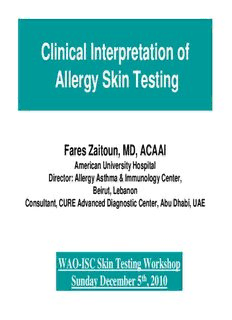
Clinical Interpretation of Allergy Skin Testing PDF
Preview Clinical Interpretation of Allergy Skin Testing
Clinical Interpretation of Allergy Skin Testing Fares Zaitoun, MD, ACAAI American University Hospital Director: Allergy Asthma & Immunology Center, Beirut, Lebanon Consultant, CURE Advanced Diagnostic Center, Abu Dhabi, UAE WAO-ISC Skin Testing Workshop Sunday December 5th, 2010 Outline • Immunopathological basis of allergy skin testing • Clinical interpretation of allergy skin testing • Pearls and Pitfalls of allergy skin testing Allergens, IgE Acute: - Anaphylaxis - Other Mast Cells Eosinophils Chronic: - Rhinitis - Asthma - Atopic derm Other factors, not - Other IgE Photos from Parham Skin prick testing Allergy Skin testing = Detection of Specific IgE “at work” • Provides information that the sensitization process has been initiated and that the patient is Atopic • Along with a positive case history, confirms the suspicion and identifies allergen(s) likely responsible for the Allergic patient’s symptoms • Without symptoms, may predict the later development of allergic disease • Identifies environmental and food avoidance strategies as part of the overall treatment • Directs physician in institution of an effective pharmaceutical and immunomodulating treatment plan Clinical Indications for allergen skin testing • To determine if an Ig-E mediated allergic mechanism exists in a clinical setting that is known or suspected to be IgE-mediated • To determine type and scope of sensitizations and help identify clinically relevant allergens • To help formulate treatment plan: Diagnostic trial with medications, when to start or stop medications, environmental control measure, allergen immunotherapy… • To obtain possible prognostic information for long-term and follow-up recommendations Allergy Skin Test interpretation • Only a clinician who has interviewed and examined a patient can determine the clinical importance of a skin test result • Interpretation of skin tests starts during the Interview process..... First the history, next the history, then the history - Physical examination – Think about the differential Dx – Ordinary lab tests, x-rays and other studies as indicated – Consider reasons for testing and how will test results be used – Revise differential Dx; formulate working Dx Before testing, the Allergy Specialist must know the following: • Specific clinical history of patient after directed interview • Type, duration and severity of symptoms and/or affected organ systems • Current and past medical, family and environmental history • Known or suspected local or regional indoor & outdoor allergens • Knowledge of foods, food allergens, food chemistry • Knowledge of allergen cross-reactivity • Purpose of testing and clinical action upon test results • Natural history of disease process • Prognostic information that tests may provide Caveats • Allergy skin tests are best regarded as tests for the presence or absence of specific IgE and not necessarily disease. • Some patients with the classic “allergic” diseases have easily demonstrable specific IgE Ab, and others do not. • Even in a symptomatic individual, a positive test result in and of itself is not necessarily clinically relevant. • IgE is normally present in the body although at very low levels • Numerous studies of subjects without overt clinical disease have demonstrated specific IgE by skin testing or specific IgE immunoassay in about 15% and up to 30% especially in those with a positive family history
Description: